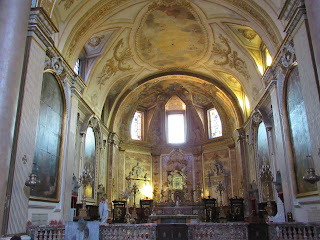Michelangelo was the original architect whose plan was used to build the church within the ruins of the Baths. Michelangelo designed the interior after the pattern of a Greek cross, using a dominant transept with chapels at either end, but died before the project was completed. Looking at the church from the outside, one would never guess that it was a church, since the 16th century exterior was torn down in the early 1900's to expose the original exterior of the Baths. Additional construction was made under the guidance of Luigi Vanvitelli.
Pope Clement XI hired astronomer and mathematician Francesco Bianchini to create a meridian line within the church. The line's threefold purpose was to: 1) Check the accuracy of the newly adopted Gregorian Calendar; 2) To accurately predict the date of Easter; and 3) To give Rome greater prestige. The church was chosen as the official church of the Kingdom of Italy (1870-1946).
Location:The Basilica is located in the Piazza della Repubblica, 00185, Rome, Italy
Cost: Free
Time: It is open from 7:00 am - 7:30 pm; it will take about an hour to explore
Description: The church is filled with works of art from many of Europe's famous artists - paintings, statues, architecture, etc. It is also home to the tombs of several famous individuals including: artist Carlo Maratta, Cardinal Francesco Alciati, sculptor Pietro Tenerani, and Presidente Vittorio Emmanuele Orlando (known as President of the Victory in WWI) among others.
 |
| John the Baptist |
The Transept contains 16 pillars - half of which were preserved from the original Baths, and the other half are copies. It houses 8 large paintings that were brought over from St. Peter's Basilica. Here you can see the Meridian Line which runs along the meridian line that passes through Rome at latitude 15*. At true noon (12:15; 1:15 during daylight savings) the sun casts its light on the line through a hole cut into the wall.
The Chapel of St. Bruno was built for the 1700 Jubilee and is dominated by an altarpiece featuring The Apparition of the Virgin Mary to Saint Bruno. On the left hand side of the chapel is the Organ of Saint Mary of the Angels. It was given to Pope John Paul II by the people of Rome in commemoration of the Great Jubilee of 2000. It was built by Barthèlèmy Formentelli and is used both at Mass and seasonal concerts. To hear the organ being played, come to the Basilica on Saturdays at 6:00 pm, or Sundays at 10:30 am, noon or 6:00 pm.
Other chapels in the church include the Chapel of St. Peter, the Chapel of Blessed Niccolo Albergati, the Chapel of St. Hyacinth, the Chapel of the Crucifix, the Chapel of Relics and the Chapel of the Savior, which is the oldest chapel in the church. The altarpiece depicts The Incarnation of Jesus and The Adoration of the Seven Angels. It is surrounded by 24 smaller paintings, attributed to Hendrik van der Brock, depicting scenes from the life of Christ.
Rating: 4 stars (out of 5)
Things You Should Know: - The Roman National Museum of the Diocletian Baths is adjacent to the church.
- There is a courtyard with some statues at one end of the church. There is also a small museum with a timeline of the church as well as various artifacts.
Nearby: Museo Nazionale Romano: Terme di Diocleziano, Chiesa di Santa Maria della Vittoria, Sant'Andrea al Quirinali, Piazza Barberini, Basilica Papale di Santa Maria Maggiore









No comments:
Post a Comment